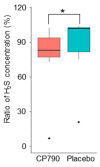Effects of Heat-Treated Lactobacillus helveticus CP790-Fermented Milk on Gastrointestinal Health in Healthy Adults: A Randomized Double-Blind Placebo-Controlled Trial
- PMID: 39064634
- PMCID: PMC11280423
- DOI: 10.3390/nu16142191
Effects of Heat-Treated Lactobacillus helveticus CP790-Fermented Milk on Gastrointestinal Health in Healthy Adults: A Randomized Double-Blind Placebo-Controlled Trial
Abstract
Probiotic-fermented milk is commonly used to maintain intestinal health. However, the effects of heat-treated fermented milk, which does not contain live microorganisms, on intestinal function are not yet fully understood. This study aimed to investigate whether heat-treated Lactobacillus helveticus CP790-fermented milk affects fecal microbiota and gut health as a "postbiotic". A randomized, double-blind, placebo-controlled trial was conducted in healthy Japanese individuals aged 20-59 years with a tendency toward constipation. Participants consumed 100 mL of either the test beverage (n = 60) or placebo beverage (n = 60) for four weeks. The test beverages were prepared with heat-treated CP790-fermented milk, while the placebo beverages were prepared with nonfermented milk flavored with lactic acid. Fecal samples were analyzed using 16S rRNA gene sequencing. Constipation symptoms were assessed using defecation logs and the Patient Assessment of Constipation Symptoms (PAC-SYM) questionnaire. Mood state was also assessed using the Profile of Mood States 2 (POMS2) questionnaire to explore its potential as a "psychobiotic". Desulfobacterota were significantly decreased by CP790-fermented milk intake. PICRUSt2 analysis predicted a decrease in the proportion of genes involved in the sulfate reduction pathway following the consumption of CP790-fermented milk. The CP790-fermented milk intervention significantly improved stool consistency and straining during defecation. These improvements were correlated with a decrease in Desulfobacterota. After the intervention, overall mood, expressed as total mood disturbance, and depression-dejection were significantly better in the CP790 group than in the placebo group. These results suggest that the intake of CP790-fermented milk could be effective in modulating gut microbiota and improving constipation symptoms and mood states.
Keywords: Lactobacillus helveticus; constipation; gut microbiota; mood state; postbiotic.
Conflict of interest statement
R.T., M.Y., K.S., S.M., D.S. and T.H. are employees of Asahi Quality and Innovations, Ltd., an affiliate of Asahi Group Holdings, Ltd. S.E. declares no conflicts of interest.
Figures






References
Publication types
MeSH terms
Grants and funding
LinkOut - more resources
Full Text Sources
Medical

